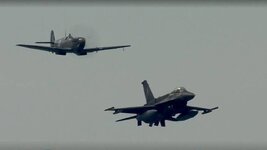GregP
Major
Hypothetical, how would a P47 go head to head in a one on one dogfight after the merge with a 190A or MkIX LF at low altitude?, the Jug pilot would haul the big girl around only to find the other two already in a firing position, same for high altitude, at 30,000ft the Jug pilot would turn losing height only to once again look over his shoulder to see a TA152/Spit XIV bearing down on him from above, the P47 was a B&Z fighter which is fine if you are in a position to bounce your enemy but in a straight dogfight it's weight puts it at a serious disadvantage.
The likelihood of seeing a flying Ta 152 was very close to zero. They completed over 150 airframes but only delivered about 43 to combat units, not all at the same time, and there were never more than about 20 flying simultaneously over the entire war. That from Adolph Galland, who should know if anyone should know. It also was not a low-altitude dogfighting airplane. The Fw 190 was also not the best dogfighter due to the zero-warning stall, meaning it could roll rapidly, but most pilots could not pull it as hard as they wanted, especially at low altitude since the stall was known to be somewhat vicious. I'd bet it would still out-turn a low-altitude P-47, though.
The P-47 didn't have the no-warning stall issue and handled pretty well as well as conventionally. The P-47 was also generally the best high-altitude fighter that was built in any substantial numbers. The Ta 152 may have BEEN a bit better, but there weren't anywhere near enough to even be dangerous.
Their total victory count for the entire war was anywhere from 6 to 10 victories (depending on who you believe) balanced against 2 to 4 losses in air-to-air combat. Granted, that was mostly due to the war situation coupled with rushing the Ta 152 into production before it was ready, no training on them, and no spare parts for the units that flew them. Still, 6 to 10 victories from 43 airplanes gives the Ta 152 a HUGE numerical and kill-ratio disadvantage over the P-47, which doesn't have a bad war record at all.
By the way, my German claims file shows 1,102 claims for P-47s in about 2 years of combat flying, which is pretty much in line with, though a bit lower than, the P-51 claims.
Last edited:

